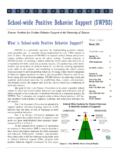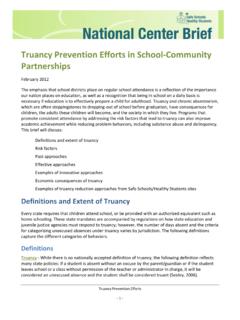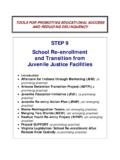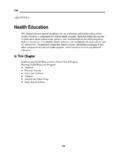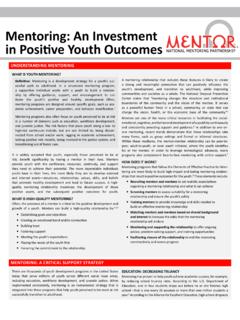Transcription of Check in Check out - Kansas School-wide PBS
1 1 Lori Newcomer, 2009 University of Missouri Check in Check out (Crone, Horner, Hawken, 2004) SCHOOLWIDE SYSTEMS OF POSITIVE BEHAVIOR SUPPORTU niversity of Missouri Columbia, Missouri Tier 2 Interventions Lori Newcomer, 2 Lori Newcomer, 2009 University of Missouri Check in and Check out: The Behavior Education Program (Crone, Horner, Hawken, 2004) Purpose: Increased collaboration between school and home and increased opportunities for self management. Essential Features: Increased structure; Check in, Check out; connection with key adult Who can benefit? Students with low level, disruptive problem behavior across settings Students with a pattern of office referrals Students who receive a number of office referrals above data decision mark Students who find adult attention reinforcing For whom is the intervention not appropriate?
2 Students with serious or violent behavior Students for whom referrals are context driven ( unsupervised playground) or when referrals come from one location. Adjust the reinforcer to match the function: Adult attention: Check in with adult, teacher and parent Peer attention: Use peer interaction or activity as earned reinforcer Escape / Avoid: Reduce adult interaction, use homework pass, early dismissal, choice, etc. as reinforcer Lack of academic or organizational skills. Focus BEP goals on academic organization. Consider Organization Check Up as targeted intervention. Basic Approach: 1. Define behavioral expectations 2.
3 Teach the expectations 3. Build a regular cycle of checking in and checking out with adults. 4. Formalize consequences for problem behaviors across the school and home. 5. Collect information for ongoing evaluation and adaptation. Lori Newcom Critical F1. PersoPrimary rDPR dataprocess Bmeeting; CoorTask MornAfterEnterspreaMaintPrioriProceCreat reviewCompmeet mer, eatures of tonnel assignresponsibilita onto spreaBEP referrals; (h) completdinators Timning Check in noon Check or DPR data onadsheet/data tain records itize BEP studess BEP referrte BEP graphsw plete tasks froings the BEP ed (BEP cooties are to (adsheets on as.))
4 (f) create te any tasks me AllocationFr5 out 5 to base 5 5 dents 1 rals Ass for 1 om As rdinator) to ) lead morna daily basisBEP graphs fassigned at n requency times per wetimes per wetimes per wetimes per wetime per wees neededtime per wees needed 2009oversee imping Check in; (d) maintafor team revteam meetiDeek3eek1eek2eek1ek21ek36 Tplementation; (b) lead aftin records inview; (g) prioings. Duration 30 minutes10 15 minutes20 minutes15 minutes20 minutes10 20 minut30 minutes60 minutesTOTAL TIME on of systemternoon chen central locoritize studeTota150 mis50 75 100 mi75 min20 mines10 2030 min60 minApproxUniversity of M. eck out; (c) eation; (e) ents for teamal time / weeinutes minutesinutes nutes nutes 0 minutesnutes nutes ximately 7 8 3 Missouri enter m ek hours4 Lori Newcomer, 2009 University of Missouri 2.
5 Determine problems to be addressed by BEP system: Academic Behavior (escape or attention maintained) Academic and behavior 3. Determine goals for students on the program. 4. System in place to track student progress on the BEP program. 5. In service for all staff on how to implement BEP system. 6. Provide information to parents regarding program via newsletter, parent conferences, or orientation. Morning Check in 1. Greet each student individually. 2. Collect the signed (by parents) DPR from the previous day. 3. Check to see if student has loose leaf paper, pens, pencils, and other necessary items for the day (provide extras to the student if necessary).
6 4. Student takes a new DPR, signs and dates it. 5. Prompt student to have a good day and meet his or her BEP goals. 6. Give student reinforcer ticket or equivalent for checking in successfully. Enter DPR Data CICO data can be entered using an EXCEL spreadsheet** or the Check in Check out (CICO) function on SWIS. If using SWIS, contact your SWIS facilitator for assistance in setting up your CICO account. If using an excel spread sheet: 1. Each student is entered on database with a corresponding line of data 2. Each day add a new date for a new column of data from the day before. 3. Enter the percentage points earned by the student in the cell that matches the new date with the student s name.
7 **Downloadable XLS spreadsheets available at: Download daily summaries and weekly summaries xls CICO templates Student's NameYear2008 CommentsStandard75%WeekPossible PointsPoints EarnedWeekly %9/1 Review meetings - October 9, Nov. 12, Entry SectionWeekly Check In Check Out Data Percentage of Points Earned 5 Lori Newcomer, 2009 University of Missouri Creating BEP Graphs Data should be graphed for all students for review at the team meeting. The coordinator may choose to print only those students who are priority students for the meeting, however, a master file should be kept of all weekly graphs. Prioritizing Students The Coordinator should review all student graphs prior to the meeting.
8 Students who continue to perform poorly, have poor attendance or have received detention or suspension should be reviewed by the team. Office referrals, detention and suspension decisions and progress reports should be reviewed by the team. Data Review At the Tier 2 team meeting, the team should (a) review the BEP graphs, (b) look at office discipline referral reports, and (c) review any information that adds to the understanding of the student. The team should then make one of 4 decisions: Student is ready to be removed from BEP Things are going fine; keep on current BEP Having some problems think of simple additional supports (Who is responsible?)
9 Timeline?) Having larger problem student needs a comprehensive, function based assessment and intervention (Who is responsible? What is the timeline?) For more information on Check in Check out: Crone, , Horner, R., & Hawkins, (2007). Responding to problem behavior in schools: The Behavior Education Program. New York, NY: The Guilford Press. **Examples of Check in Check out forms can be downloaded at: 6 Lori Newcomer, 2009 University of Missouri Check in Check out Point Sheet Name_____ Date _____ Points Possible _____ Goal Met _____ Points Received_____ 2 = excellent % Percent of Points _____ 1= room to improve 0 = did not meet expectations Target Behaviors MATH SOCIAL STUDIES SPECIALS RECESS LANGUAGE ARTS SCIENCE Be Respectful: Use appropriate language 2 1 0 2 1 0 2 1 0 2 1 0 2 1 0 2 1 0 Be a Learner Stay on task 2 1 0 2 1 0 2 1 0 2 1 0 2 1 0 2 1 0 Be Responsible.
10 Follow adult directions 2 1 0 2 1 0 2 1 0 2 1 0 2 1 0 2 1 0 Parent Signature.
